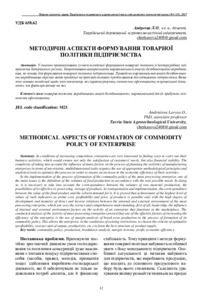Please use this identifier to cite or link to this item:
http://elar.tsatu.edu.ua/handle/123456789/6808Full metadata record
| DC Field | Value | Language |
|---|---|---|
| dc.contributor.author | Андрєєва, Лариса Олександрівна | - |
| dc.contributor.author | Андреева, Лариса Александровна | - |
| dc.contributor.author | Andrieieva, Larysa | - |
| dc.date.accessioned | 2019-05-07T08:34:57Z | - |
| dc.date.available | 2019-05-07T08:34:57Z | - |
| dc.date.issued | 2017 | - |
| dc.identifier.uri | http://elar.tsatu.edu.ua/handle/123456789/6808 | - |
| dc.description.abstract | UK: У статті проаналізовано сучасні тенденції формування товарної політики м'ясопереробних підприємств Запорізького регіону. Запропоновано використання маржинального аналізу беззбитковості виробництва, як основи для формування товарної політики підприємства. Проведено маржинальний аналіз беззбитковості виробництва окремих видів продукції на прикладі типових представників досліджуваних підприємств. Виявлено основні тенденції щодо змін показників, які характеризують економічну ефективність торговельної діяльності, та фактори впливу на них. EN: In conditions of increasing competition, enterprises are very interested in finding ways to carry out their business activities, which would ensure not only the satisfaction of customers' needs, but also financial stability. The complexity of taking into account the influence of many factors on the process of planning the activities of manufacturing enterprises in terms of uncertainty, multidimensional tasks requires the use of appropriate methodological principles and analytical tools to optimize this process in order to ensure an increase in the economic efficiency of their activities. In the implementation of the process of formation of the commodity policy of the meat processing enterprise, one of the main issues is the definition of the volumes of food production in accordance with the real possible needs. In doing so, it is necessary to take into account the correspondence between the volumes of raw material production, the possibilities of its effective re-processing, storage of products, its transportation and implementation, the correspondence between the value of the final product and the solvent demand for it. It is proved that achievement of the highest level of values of such indicators as prime cost, profitability and price of products is possible only with the high degree of development and maturity of direct and inverse relations between the internal and external environment of the meat processing enterprise, which presees the correct and comprehensive understanding, first of all, leadership, the influence of internal and external environment factors on the activity of an enterprise that functions in the marketplace. The conducted analysis of the activity of meat processing enterprises proved that one of the effective factors of increasing the efficiency of the enterprise is the use of margin analysis of breakeven production in the process of formation of its commodity policy. This allows the enterprise, in the conditions of existing restrictions, to choose the criteria of optimality (profitability, cost per unit of output, productivity, etc.) to form the best structure of product supply. | uk |
| dc.language.iso | uk | uk |
| dc.publisher | Мелітополь: ТДАТУ | uk |
| dc.relation.ispartofseries | Збірник наукових праць ТДАТУ: економічні науки;№ 3 (35) (С.12-19) | - |
| dc.subject | товарна політика | uk |
| dc.subject | виробництво | uk |
| dc.subject | аналіз беззбитковості | uk |
| dc.subject | маржинальний дохід | uk |
| dc.subject | прибуток | uk |
| dc.subject | економічна ефективність | uk |
| dc.subject | commodity policy | uk |
| dc.subject | production | uk |
| dc.subject | breakdown analysis | uk |
| dc.subject | margin revenue | uk |
| dc.subject | profit | uk |
| dc.subject | economic efficiency | uk |
| dc.title | Методичні аспекти формування товарної політики підприємства | uk |
| dc.title.alternative | Methodical aspects of formation of commodity policy of enterprise | uk |
| dc.type | Working Paper | uk |
| Appears in Collections: | Кафедра Економіки і бізнесу | |
Show simple item record
CORE Recommender
???jsp.display-item.check???
Items in DSpace are protected by copyright, with all rights reserved, unless otherwise indicated.

